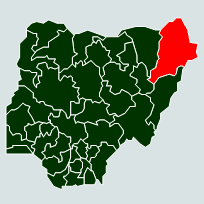BY PATRICIA TAFT AND NATE HAKEN
 Borno State, the location of the April 2014 abduction of nearly 300 school girls, is at the heart of what has been called the “Boko Haram” insurgency. The insurgency, perpetrated by a militant group called Jamāʻat Ahl as-Sunnah lid-daʻwa wal-Jihād (JAS), began in 2009 as a mass uprising against police in the states of Bauchi, Yobe, and Borno in which hundreds died. Violence de-escalated rapidly after insurgent leader Muhammed Yusuf was captured and killed. However, in 2011, the death toll began once again to rise and kept rising for the next three years. In May 2013, President Goodluck Jonathan declared a state of emergency in Borno, Yobe, and Adamawa to contain the violence. To date, the initiative has had mixed results. Violence in Maiduguri, the capital of Borno, which had been the most severely affected Local Government Area (LGA) in terms of the number of incidents and fatalities, appears to have decreased dramatically. However, according to data aggregated on the P4P Web Map, violence was merely displaced from the urban center to more rural parts of the state.
Borno State, the location of the April 2014 abduction of nearly 300 school girls, is at the heart of what has been called the “Boko Haram” insurgency. The insurgency, perpetrated by a militant group called Jamāʻat Ahl as-Sunnah lid-daʻwa wal-Jihād (JAS), began in 2009 as a mass uprising against police in the states of Bauchi, Yobe, and Borno in which hundreds died. Violence de-escalated rapidly after insurgent leader Muhammed Yusuf was captured and killed. However, in 2011, the death toll began once again to rise and kept rising for the next three years. In May 2013, President Goodluck Jonathan declared a state of emergency in Borno, Yobe, and Adamawa to contain the violence. To date, the initiative has had mixed results. Violence in Maiduguri, the capital of Borno, which had been the most severely affected Local Government Area (LGA) in terms of the number of incidents and fatalities, appears to have decreased dramatically. However, according to data aggregated on the P4P Web Map, violence was merely displaced from the urban center to more rural parts of the state.
Borno state is home to approximately 4.2 million people (2006 census). The population is mostly Muslim and ethnically Kanuri, Bura, and a few nomadic Shuwa Arabs. It is the second-largest producer of maize in Nigeria. Farmers also grow millet, rice, wheat, and cotton. Its location at the border of Niger, Chad, and Cameroon makes it strategic for trade in and out of the country. Kashim Shettima, from the All Nigeria People’s Party (ANPP), has governed Borno since winning the April 2011 gubernatorial elections.
*Valentin Robilliard contributed to this report.